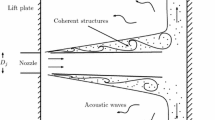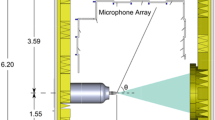Abstract
This article experimentally investigates the self-excited impinging planar jet flow, specifically, the development and propagation of large-scale coherent flow structures convecting between the nozzle lip and the downstream impingement surface. The investigation uses phase-locked PIV measurements and a new structure-tracking scheme to measure convection velocity and characterize the impingement mechanism near the plate in order to develop a new feedback model that can be used to predict the oscillation frequency as a function of flow velocity (U o ), impingement distance (x o ) and nozzle thickness (h). The resulting model prediction shows a good agreement with experimental tone frequency data.
Access provided by Autonomous University of Puebla. Download conference paper PDF
Similar content being viewed by others
Keywords
- Impinging jet
- Self-excited flow
- Acoustic tone
- Flow-acoustic interaction
- Feedback mechanism
- Coherent structure
- Vortices
- Convection speed
1 Introduction
High-speed impinging planar jets are used in a myriad of important industrial applications; however, these flows are also known to be liable to the production of very intense narrow-band acoustic tones and strong self-excited flows. These phenomena are produced by a feedback mechanism between instabilities in the free shear layers of the jet and pressure fluctuations produced by the impingement of large-scale coherent flow structures at the impingement surface. Previous investigations of the planar impinging jet have shown that the characteristics of the self-excited response of the system is different from other related geometries, such as the impinging axisymmetric jet, being self-excited over a much larger range of impingement ratio (1.5 ≤ x o/h ≤ 32.0 for the planar cases, compared with 1.5 ≤ x o/D ≤ 7.0 for round jets) and beginning at lower flow velocities (Arthurs and Ziada 2012). These distinctions result in significant differences in both the structure of the flow, as well as the form of the jet oscillation modes compared to related systems, and as a result, the existing feedback models lead to relatively poor predictions of the oscillation frequency.
2 Experimental Details
Experiments were conducted using McMaster’s planar jet noise facility, which employs a planar nozzle with a thickness of h = 3 mm, a total span of L = 100 mm, and uses compressed air as a flow source. Acoustic measurements have been performed with GRAS ¼" microphones, and flow measurements have been performed by means of a standard-speed PIV system using a phase-locked measurement technique, which acquires flow measurements at a specified point in the flow oscillation cycle using the periodic pressure signal obtained at the plate surface in the impingement region. Velocity vectors have been obtained using an iterative, multi-grid, deformation-based scheme with a final interrogation region size of 24 × 24 pixels and an overlap of 75 %. The resulting vector fields have less than 1 % interpolated vectors before the use of any vector replacement schemes.
3 Results and Discussion
3.1 Self-Excited Flow Oscillations
Figure 1 shows pair of flow fields of the impinging planar jet, with part (a) showing a phase-averaged instantaneous velocity magnitude field, consisting of the average of 100 phase-locked measurements, along with a single contour of the velocity discriminant field proposed by Vollmers (2001) at an amplitude of d 2 = 0. This flow field is indicative of the typical form of the self-excited flow of the jet, which takes the form of a pronounced flapping motion of the jet column, along with an anti-symmetric distribution of coherent flow structures on either side of the jet centerline that convect from the nozzle to the plate, and with the number of structures varying with the mode number, n. The velocity discriminant parameter, which is a nonlinear combination of velocity shear terms, has been used to identify and track coherent structures in the flow (Vollmers 2001). Part (b) of the figure shows the time-averaged velocity magnitude field, along with the position of the coherent structures extracted from eight phase-averaged flow fields evenly distributed over three repeated flow oscillation cycles.
3.2 Structure Convection Velocity and Mean Flow Effects
Using the structure positions obtained from the phase-averaged flow fields, the convection velocity of the coherent structures in the downstream direction was obtained as a function of the downstream position. The results of these measurements are shown in Fig. 2, with part (a) illustrating the effect of changing flow velocity of the jet and part (b) showing the effect of varying impingement ratio. The results in part (a) show that the structures convect relatively slowly, at ~40 % of the free-stream velocity of the jet flow in the initial region and with the changing flow velocity of the jet having no effect on the dimensionless convection velocity. Furthermore, part (b) shows that as the impingement ratio is increased, the structure shows evidence of the structure slowing due to the effects of the transition region, where the jet flow experiences a bulk-slowing effect as the flow travels beyond the jet potential core and approaches the impingement surface.
.
To account for the bulk-slowing effect brought on by the transition region for large impingement ratios, a set of expressions have been developed using the results of time-averaged centerline velocity profiles obtained for impingement ratios between x o/h = 5.0 and 30.0. The correction, given in Eqs. 1 and 2, gives the average downstream convection velocity in the developing region of the flow over two distinct ranges of impingement ratio: x o/h ≤ 8.5, where the transition region has a negligible effect, and x o/h > 8.5 where significant bulk slowing of the flow occurs.
Because of the relatively large size of the structures and the flow diversion near the plate, it is clear that the structures will begin to impinge on the downstream surface having travelled less than the total impingement distance, x o. In order to quantify this effect and to define an effective impingement length scale: x eff, measurements of the structure circulation as a function of downstream position have been performed by integrating the vorticity field within the bound of each coherent flow structure determined by the velocity discriminant d 2 = 0 level. The results of these measurements are shown in Fig. 3, which illustrates that the structure circulation reaches a maximum value having travelled ~75 % of the total impingement distance, after which it decreases sharply. The sudden decrease indicates the onset of structure impingement on the downstream surface. Measurements of other cases performed at various flow velocities and impingement ratios showed very similar results.
3.3 Feedback Model
A feedback model to predict the self-excited flow oscillation frequency is proposed based on the results of measured convection speed, mean flow characteristics and the effective impingement length. The model, which is conceptually based on the model developed by Alan Powell, is given in Eq. 4, with the predictions of the model shown in Fig. 4. The model has been found to have very good agreement with the measured oscillation frequency, typically within 10 %, for the complete range of sub-sonic flow velocity and impingement ratio for which the system is self-excited (150 ≤ U o < 343 m/s and 1.5 ≤ x o/h ≤32.0), as well as for a range of nozzle thicknesses (1.0 ≤ h ≤4.0 mm).
4 Conclusions
This article examined the development and propagation of large-scale coherent flow structures in the self-excited impinging planar jet flow in order to develop a feedback model capable of predicting the oscillation frequency. It was found that the coherent flow structures convect at ~40 % of the jet velocity in the initial region and with the structures slowing due to the effects of the transition region for large impingement ratio. In addition, the large size of the structures and flow diversion near the plate results in interaction with the plate having propagated ~75 % of the total impingement length. The feedback model that was developed using the present results shows a good agreement with experimental measured frequency for a wide range of flow velocity, impingement ratio and nozzle thickness.
References
Arthurs D, Ziada S (2012) Self-excited oscillations of a high-speed impinging planar jet. J Fluids Struct 34:236–258
Vollmers H (2001) Detection of vortices and quantitative evaluation of their main parameters from experimental velocity data. Meas Sci Technol 12:1199–1207
Author information
Authors and Affiliations
Corresponding authors
Editor information
Editors and Affiliations
Rights and permissions
Copyright information
© 2014 Springer-Verlag Berlin Heidelberg
About this paper
Cite this paper
Arthurs, D., Ziada, S. (2014). Development of a Feedback Model for the Self-Excited Impinging Planar Jet. In: Zhou, Y., Liu, Y., Huang, L., Hodges, D. (eds) Fluid-Structure-Sound Interactions and Control. Lecture Notes in Mechanical Engineering. Springer, Berlin, Heidelberg. https://doi.org/10.1007/978-3-642-40371-2_4
Download citation
DOI: https://doi.org/10.1007/978-3-642-40371-2_4
Published:
Publisher Name: Springer, Berlin, Heidelberg
Print ISBN: 978-3-642-40370-5
Online ISBN: 978-3-642-40371-2
eBook Packages: EngineeringEngineering (R0)








